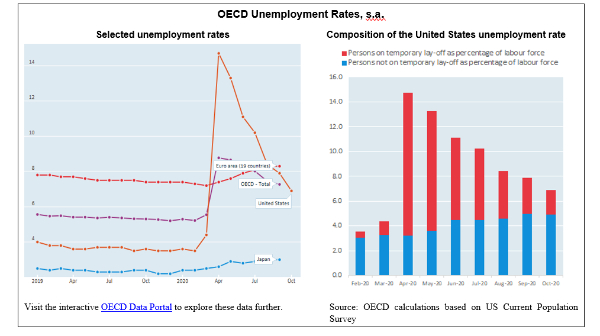Marginal Fall In OECD Unemployment Rate In September 2020 As Pace Of Improvement Slows
The OECD area unemployment rate continued to fall, albeit at a slower pace, in September 2020, to 7.3%, from 7.4% in August. The rate remains 2.1 percentage points higher than in February, before the COVID-19 pandemic hit the labour market.
Some care is needed in interpreting recent falls in the OECD unemployment rate, as this largely reflects the return of temporary laid-off workers in the United States and Canada, where they are recorded as unemployed[1], whereas they are typically recorded as employed in most other countries.
In the euro area, where temporary lay-offs are not included in unemployment, the unemployment rate was stable at 8.3% in September, 1.0 percentage point higher than in February. France saw the highest increase (up by 0.4 percentage point, to 7.9%) within the euro area, while Latvia (8.4%) and Portugal (7.7%) saw the largest decreases (0.4 percentage point).
In Canada and the United States, headline unemployment rates continued to fall, as temporary lay-offs returned to work. In September, the unemployment rate fell by 1.2 percentage points, to 9.0%, in Canada, and by 0.5 percentage point, to 7.9%, in the United States. Excluding persons on temporary lay-off unemploymentincreased by 0.6 million[2] in the United States. In October, the unemployment rate continued to fall in the United States (to 6.9%), while it declined marginally in Canada (to 8.9%). In September, the unemployment rate also declined by 0.3 percentage point or more in Colombia (to 16.6%) and Mexico (to 4.7%), while it was stable in Japan (at 3.0%), and increased by 0.6 percentage point or more in Korea (to 3.9%) and Iceland (to 5.6%).
The OECD youth unemployment rate (people aged 15 to 24) declined by 0.8 percentage point in September, to 14.6%, 3.4 percentage points higher than in February.
See the full release.

[1] For Canada and the United States, the statistical treatment of persons on temporary layoff is different from other countries. See the note on the divergence in employment and unemployment statistics during the Covid-19 crisis on next page.
[2] OECD estimate


 Global Jews for Palestine: Jewish Organisations' Passover Statement, After 40 Days Of Starvation
Global Jews for Palestine: Jewish Organisations' Passover Statement, After 40 Days Of Starvation APEC: Stronger Immunization Policies Needed As Vaccine Confidence Falls
APEC: Stronger Immunization Policies Needed As Vaccine Confidence Falls 350.org: Indigenous Groups From The Pacific, Brazil & Canada Hand Demands To COP30 Presidency To End Fossil Fuels
350.org: Indigenous Groups From The Pacific, Brazil & Canada Hand Demands To COP30 Presidency To End Fossil Fuels Conservation International: Conservation International Expedition Reveals Ecosystem Recovery In Tokelau
Conservation International: Conservation International Expedition Reveals Ecosystem Recovery In Tokelau UN Special Procedures - Human Rights: UN Expert Urges States To Finance Inclusive And Sustainable Development, Not A War Economy
UN Special Procedures - Human Rights: UN Expert Urges States To Finance Inclusive And Sustainable Development, Not A War Economy Amnesty International Aotearoa NZ: Global - Recorded Executions Highest Since 2015
Amnesty International Aotearoa NZ: Global - Recorded Executions Highest Since 2015